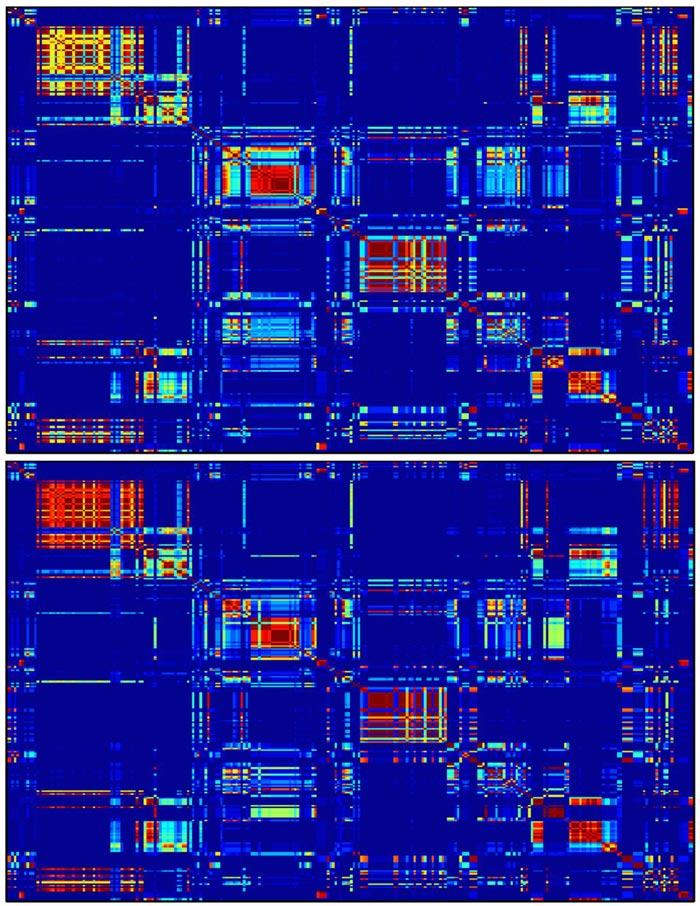Penn and German researchers help identify neural basis of multitasking

These plots show connection strength between nodes in the brain during the control task (top) and the memory task (bottom). Brain regions are arrayed on both the X and Y axes; the strength of their connection is indicated by the color of the coordinate where they meet. Credit: Proceedings of the National Academy of Sciences
By studying networks of activity in the brain's frontal cortex, a region associated with control over thoughts and actions, the researchers have shown that the degree to which these networks reconfigure themselves while switching from task to task predicts people's cognitive flexibility.
Experiment participants who performed best while alternating between a memory test and a control test showed the most rearrangement of connections within their frontal cortices as well as the most new connections with other areas of their brains.
A more fundamental understanding of how the brain manages multitasking could lead to better interventions for medical conditions associated with reduced executive function, such as autism, schizophrenia or dementia.
Danielle Bassett, the Skirkanich Assistant Professor of Innovation in Penn's School of Engineering and Applied Science, is senior author on the study. Manheim's Urs Braun and Axel Schäfer were the lead authors. The research also featured work from Andreas Meyer-Lindenberg and Heike Tost of Mannheim, Henrik Walter of Charité, and others.
It was published in the Proceedings of the National Academy of Sciences.
Rather than looking at the role a single region in the brain plays, Bassett and colleagues study the interconnections between the regions as indicated by synchronized activity. Using fMRI, they can measure which parts of the brain are “talking” to one another as study participants perform various tasks. Mapping the way this activity network reconfigures itself provides a more holistic view of how the brain operates.
“We try to understand how dynamic flexibility of brain networks can predict cognitive flexibility, or the ability to switch from task to task,” Bassett said. “Rather than being driven by the activity of single brain areas, we believe executive function is a network-level process.”
A previous study that Bassett led showed that people who could more quickly “disconnect” their frontal cortices did better on a task that involved pressing keys that corresponded to color-coded notes on a screen. The high level decision-making associated with the frontal cortex's cognitive control wasn't as critical to playing the short sequences of notes, so those who still engaged this part of the brain were essentially overthinking a simple problem.
In the new experiment, lead by Andreas Meyer-Lindenberg of Mannheim, 344 participants alternated between a working memory task designed to engage the frontal cortex and a control task. The easy task involved pressing the corresponding button as a sequence of numbers appeared on a screen one by one. The hard task also involved a sequence of numbers on a screen, but participants had to press the button that corresponded to the number that appeared two places back in the series each time they saw a new one.
Urs Braun and Axel Schäfer, the lead authors on the paper, collaborated with Bassett, who has developed novel tools from network science to distill evolving brain connections. They used these tools to map how participants' brain activities rearranged during each block of the working memory task, each block of the control task and blocks in between where participants switched gears.
“The nodes in the network that are most involved in reconfigurations are cognitive control areas in the frontal cortex,” Bassett said. “More flexibility within the frontal cortex meant more accuracy on the memory task, and more consistent connectivity between the frontal cortex and other regions was even more predictive.”
While the predictive strength of this reconfiguration suggests that it is only one of several processes involved in successful task switching, it plays a core role.
“It doesn't account for a huge amount variance,” Bassett said, “but it suggests that this kind of reconfiguration is a fundamental aspect of cognitive flexibility.”
###
Other researchers who contributed to the study include Susanne Erk, Nina Romanczuk-Seiferth and Andreas Heinz of Berlin, and Leila Haddad, Janina I. Schweiger and Oliver Grimm of Mannheim.
The research was supported by the John D. and Catherine T. MacArthur Foundation; Alfred P. Sloan Foundation; Army Research Laboratory through contract W911NF-10-2-0022; Institute for Translational Medicine and Therapeutics at Penn; National Institute of Mental Health through award 2-R01-DC-009209-11; National Science Foundation through awards BCS-1441502 and BCS-1430087; German Federal Ministry of Education and Research through grants 01GS08144, 01GS08147 and 01GS08148; Innovative Medicines Initiative Joint Undertaking though grant agreement 115008; and German Federal Ministry of Education and Research through BMBF 01GQ1102.
Media Contact
All latest news from the category: Social Sciences
This area deals with the latest developments in the field of empirical and theoretical research as it relates to the structure and function of institutes and systems, their social interdependence and how such systems interact with individual behavior processes.
innovations-report offers informative reports and articles related to the social sciences field including demographic developments, family and career issues, geriatric research, conflict research, generational studies and criminology research.
Newest articles

Innovative vortex beam technology
…unleashes ultra-secure, high-capacity data transmission. Scientists have developed a breakthrough optical technology that could dramatically enhance the capacity and security of data transmission (Fig. 1). By utilizing a new type…

Tiny dancers: Scientists synchronise bacterial motion
Researchers at TU Delft have discovered that E. coli bacteria can synchronise their movements, creating order in seemingly random biological systems. By trapping individual bacteria in micro-engineered circular cavities and…

Primary investigation on ram-rotor detonation engine
Detonation is a supersonic combustion wave, characterized by a shock wave driven by the energy release from closely coupled chemical reactions. It is a typical form of pressure gain combustion,…



